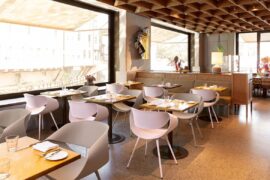A guide to population density trends in Australia and what it means for urban development.

March 25th, 2022
One comprehensive population density definition is: a proportionate measurement of a population (usually of humans, but potentially any living organism) with respect to a unit area. It refers to the concentration of the studied group within this area and is measured by the number of people / square kilometer (or square mile), though of course smaller area measurements may be used for smaller focus areas. The population density formula is: Dp (population density) = N (total population) / A (land area covered by population).
Increasing by 1.3% from 2020, Australia’s current population density is 3.33 people / square km, the biggest it has ever been. Population density can be drastically different to the population total – for example, Sydney is the most populated city in Australia yet it only ranks 4th highest for population density. The least populated city in Australia, Dubbo, has a higher population density than Hobart despite housing only 38,392 people in comparison to Hobart’s 206,097.
According to the World Population Review, the city with the highest population density in Australia is Darwin, at 733.7 people per square kilometer. The city with the lowest population density in Australia is Hobart, which has an average of 125 people per square kilometer. Measuring by states, the ACT has the highest population density (179 people / square km) and the Northern Territory has the lowest (0.2 people / square km). The most densely populated area in Australia was inner-city Melbourne (20,700 people / square kilometer), followed by Woolloomooloo in inner Sydney (16,600 people / square kilometer).

Overall, Australia has the 7th lowest population density in the world, coming in at 226th and immediately followed by Iceland (3 people / square kilometer). This is largely due to Australia’s vast size, as the sixth-largest country in the world. Another factor is the prevalence of rural and farm life spreading the population sparsely around the country, and the fact that much of inland Australia is uninhabited. However, even the density of Australia’s capital cities is low by global standards; not one Australian city even makes the world’s top 60 for population density.
Find a list of population density by country below, featuring the countries with the 10 highest population densities ordered from lowest to highest. The most densely populated country is Monaco.
10. Mauritius 626 people / square kilometer
9. Lebanon 667 people / square kilometer
8. Barbados 668 people / square kilometer
7. Vatican City 924 people / square kilometer
6. Bangladesh 1,265 people / square kilometer
5. Malta 1,642 people / square kilometer
4. Maldives 1,802 people / square kilometer
3. Bahrain 2,182 people / square kilometer
2. Singapore 8,019 people / square kilometer
1. Monaco 19,361 people / square kilometer

Find a list of the countries with the lowest population density below, ordered from highest (most dense) to lowest (least dense). The least densely populated country is Greenland.
10. Guyana 4 people / square kilometer
9. French Guiana 4 people / square kilometer
8. Suriname 4 people / square kilometer
7. Australia 3 people / square kilometer
6. Iceland 3 people / square kilometer
5. Namibia 3 people / square kilometer
4. Western Sahara 2 people / square kilometer
3. Mongolia 2 people / square kilometer
2. Falkland Islands 0.28 people / square kilometer
3. Greenland 0.03 people / square kilometer

Four of the most densely populated cities in the world are found in the Philippines. Find a list of population density by city below, featuring the world’s 10 most densely populated cities, ordered from lowest to highest.
10. Levallois-Perret, France 26,713 people / square kilometer
9. Bnei Brak, Israel 27,338 people / square kilometer
8. Port-au-Prince, Haiti 27,395 people / square kilometer
7. Caloocan, Philippines 27,989 people / square kilometer
6. Dhaka, Bangladesh 29,069 people / square kilometer
5. Mumbai, India 32,303 people / square kilometer
4. Baghdad, Iraq 32,874 people / square kilometer
3. Mandaluyong, Philippines 34,925 people / square kilometer
2. Pateros, Philippines 36,447 people / square kilometer
1. Manila, Philippines 46,178 people / square kilometer

Find the population density of each Australian capital city below, ordered from lowest to highest.
8. Hobart 125 people / square kilometer
7. Perth 295.5 people / square kilometer
6. Brisbane 346 people / square kilometer
5. Adelaide 422.3 people / square kilometer
4. Sydney 442.3 people / square kilometer
3. Canberra 495.6 people / square kilometer
2. Melbourne 516.7 people / square kilometer
1. Darwin 703 people / square kilometer

Have a look at this diagram from Per Square Mile, an urban planning blog.
It shows how the entire population of the world would easily fit within America if the global population all lived as densely as these cities.

Population density has been the driving force for the majority of Architectural advancements. Particularly, the invention of the skyscraper was a solution devised by architects to deal with growing population density in a space-efficient way. Public transport is often a major architectural concern when population density begins to grow, as road infrastructure will likely be unable to support huge crowds of people each with individual transport.
The metro system of Hong Kong, China, is recognized as one of the best public transport systems in the world. Hong Kong is able to cater for its high density population (6,300 people / square kilometer) with affordable and functional public transport that turns a profit in the low billions. Cities like New York, on the other hand, struggle just to afford transport maintenance and do not take advantage of population density in the same way that the MTR Corporation does in Hong Kong (by bargaining for the profits of malls to which they transport customers, developing property on and around the public transport area, having retail centers within the subway stations themselves, etc.). Hong Kong’s success is directly related to the population density; because there are no suburbs from which people can drive personal vehicles to commute, the transport system becomes the main method of transportation.
It is important for architecture to strike a balance between potentially space wasting structures – for example, American suburban set ups with only one house/family on large blocks of land – and overcrowding, which can be seen in cities like Mumbai where land prices have skyrocketed and residents are forced into long commutes from cheaper housing far from work. It is worth remembering the impacts of architecture on human psychology, especially in situations of high density where the potential for stress and conflict greatly increases. Have a look at this article to read more about the social and psychological implications of high-density housing.

Australia has already seen a huge increase in architecture catering to a population increasing in density. Have a look here for a list of Australia’s current skyscrapers and their features; most of these buildings are multifunctional and cater to a variety of office, residential apartment and retail demands. The West Side Place, the Orion Towers and 56 Pitt St, Sydney are all skyscrapers currently in development which will cater to Australia’s increasing population density in major cities. Multistory buildings are certain to become staples of Australia’s construction future, though in which direction is not set in stone. Some influential figures such as Elon Musk are currently advocating for a switch to inverted skyscrapers, or ‘Earthscrapers’ as population density growth is set to increase beyond the capabilities of skyscrapers.
INDESIGN is on instagram
Follow @indesignlive
A searchable and comprehensive guide for specifying leading products and their suppliers
Keep up to date with the latest and greatest from our industry BFF's!

The undeniable thread connecting Herman Miller and Knoll’s design legacies across the decades now finds its profound physical embodiment at MillerKnoll’s new Design Yard Archives.
The new range features slabs with warm, earthy palettes that lend a sense of organic luxury to every space.
Singapore’s first standalone rooftop bar has been completely tr…
Read more: http://www.indesignlive.asia/articles/in-review/events/Haworth-xFriends#ixzz1w7snKLhq

Adaptability means everything in today’s workplace climate. Zenith have crafted the ideal flexible space with the Precinct range: creating spaces within spaces.
The internet never sleeps! Here's the stuff you might have missed

Emily Moss, Brooke Lloyd, Juliette Arent Squadrito and Alexandra Ramundi joined Alice Blackwood at Living Edge’s stunning showroom to discuss a milestone approach to design.

We think of the chair as a ubiquitous object but every now and then there is a design that ticks all the boxes and makes its presence felt on the global stage.